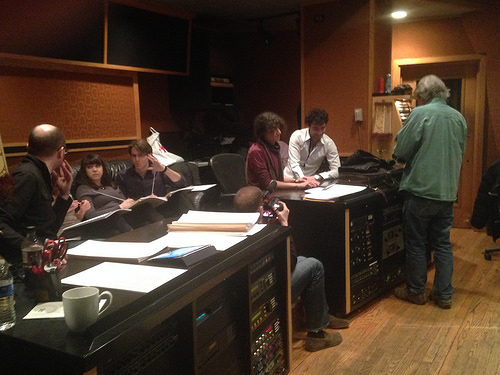
Recording Sessions
[flickr id=”13389590964″ thumbnail=”medium” overlay=”true” size=”medium” group=”” align=”none”]
Over the last month, I had the privilege to attend two orchestral recording sessions. Three recording sessions are dispersed over the second year of study here at Columbia. It was a great opportunity to sit in, as many of my year one classmates did as well. We learned a great deal about score preparation, how to communicate to professional musicians, and how recording sessions are run. It is odd to think me and my year one classmates will be running our own sessions in one year. I am very proud of all the second year students. Their pieces were beautifully performed by the Chicago musicians.
https://t.co/slsUgNVMaf Recording Session #2
— MusicComp MFA (@MusicCompMFA) March 24, 2014
The live instruments used were a dozen string players, bassoon, flute, clarinet, oboe, french horn, and harp. The live elements are recorded and added to the original track. The electronic elements work together with the the live strings, brass, and woodwinds to sweeten the mix. To create a larger sounding section, the strings are often recorded twice. This can be done by conducting to a click track, to make sure everything is lining up correctly. Our professors help run these recordings, as they have many years of session experience. Gary Chang, David McHugh, and Andrew Edwards were all concentrated on detailed listening to the performances and giving tips here and there to improve the performance. They were scanning the score as well, and suggesting where to “punch in” to redo a certain passage. Allen Tinkham, the second year conducting teacher, also showed up to give tips to how the students were conducting.
Year two recording session, Tracie conducting. https://t.co/TNmos7Pjaw #ChicagoRecordingCompany
— MusicComp MFA (@MusicCompMFA) March 14, 2014
Students have the freedom to choose which pieces they want to record. It could be from a student film, or just a piece that you want to have recorded live. These recordings will be an important addition to the students’ portfolios. Hearing the quality of the finished product is very inspiring. Take a listen to pieces from Jordan Lewis and Steven Melin.
[soundcloud url=”https://api.soundcloud.com/tracks/141110912″ params=”color=ff5500&auto_play=false&hide_related=false&show_artwork=true” width=”100%” height=”166″ iframe=”true” /]
[soundcloud url=”https://api.soundcloud.com/tracks/138664866″ params=”color=ff5500&auto_play=false&hide_related=false&show_artwork=true” width=”100%” height=”166″ iframe=”true” /]
The final recording session is at Capitol Records during the summer semester in LA. This session is the culmination of all the knowledge gained from the previous three recording sessions. The instrumentation increases—students have access to a very large string and brass section. Here is an example composed and produced by Mason Kaye, a previous ambassador of this program.
[soundcloud url=”https://api.soundcloud.com/tracks/55674155″ params=”color=ff5500&auto_play=false&hide_related=false&show_artwork=true” width=”100%” height=”166″ iframe=”true” /]
